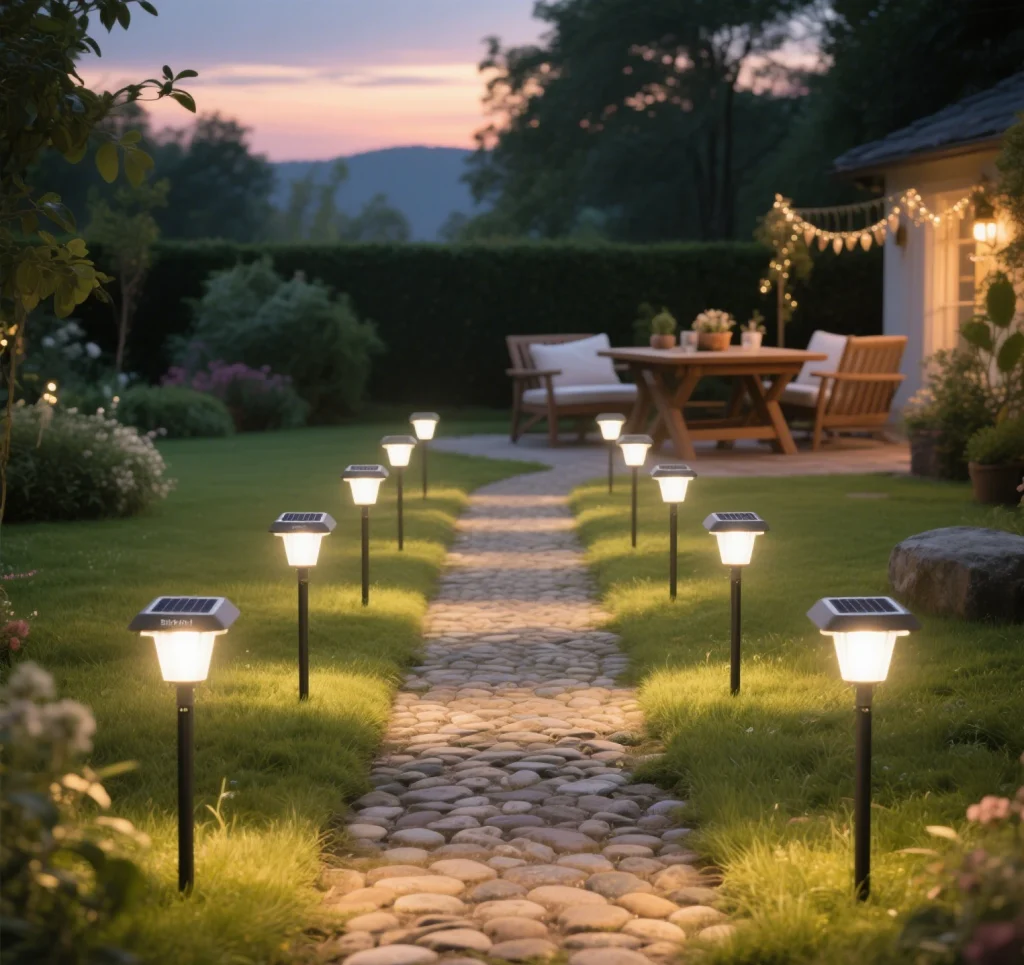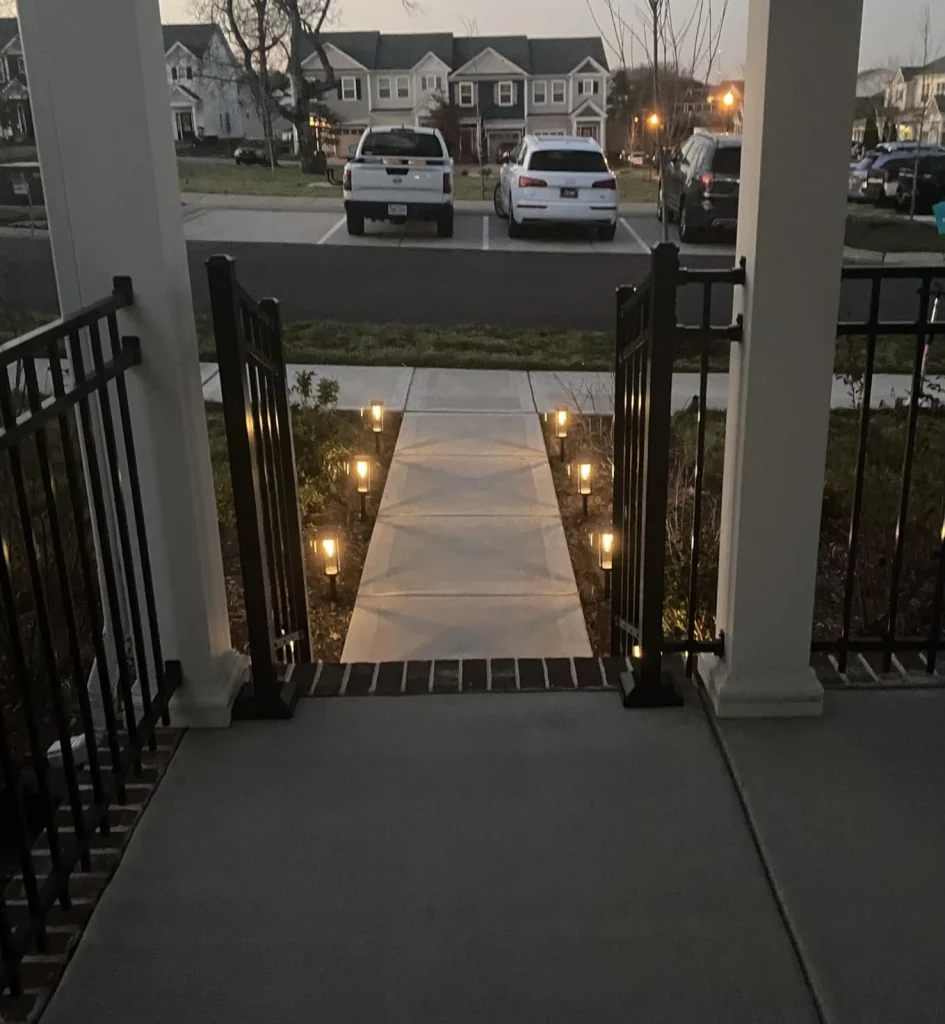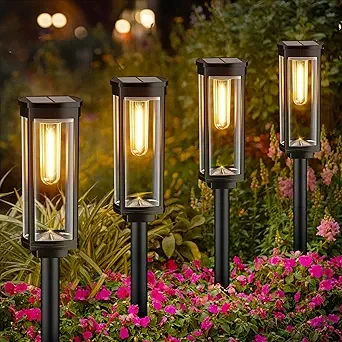When creating a dreamy courtyard night scene, solar garden lights have become the preferred choice for more and more families due to their environmentally friendly and energy – saving features. Bitpott, as a high – quality brand deeply rooted in the solar lighting field, is always committed to providing consumers with high – performance products. Among the many components of solar garden lights, the battery, as the core energy – storage component, directly affects the usage experience and lifespan of the lights with its performance. Currently, lithium iron phosphate batteries and lead – acid batteries are the mainstream choices in the market. What are the differences between the two? How can you select the right “heart” for your solar garden lights? Let’s explore these questions in depth.

I. Charging Efficiency: Lithium Iron Phosphate Batteries Take the Lead
During the operation of solar garden lights, the charging efficiency of the battery determines the lighting duration of the lights under different lighting conditions. Lithium iron phosphate batteries demonstrate remarkable charging advantages, with a charging efficiency of up to 98%, while the charging efficiency of lead – acid batteries is only 60%. Take Shanxi Province as an example. Assuming a 100W solar panel is equipped, under local weather conditions, a lithium iron phosphate battery can store approximately 45W – 75W of electricity per day, while a lead – acid battery can only store 27W – 45W, almost half the amount. This means that the charging effect of two lead – acid batteries is equivalent to that of one lithium iron phosphate battery. In practical applications, with the same battery capacity, a lithium iron phosphate battery can continuously power a 60W garden light, while a lead – acid battery can only meet the power demand of a 30W light. Bitpott solar garden lights are equipped with lithium iron phosphate batteries, which can quickly “recharge” even on days with poor lighting conditions, ensuring stable night lighting.
II. Discharge Performance: Lithium Iron Phosphate Batteries are Stable and Powerful
Discharge performance is another key indicator for measuring the quality of batteries. The discharge voltage of lithium iron phosphate batteries is very stable, and they can even achieve 100% deep discharge at room temperature. In contrast, the maximum discharge depth of lead – acid batteries is only 60 – 70%. In actual use, for the same 12V40AH battery, a lithium iron phosphate battery can fully release 40AH of electrical energy. If the garden light works 10 hours every night, it is sufficient to support the light to work normally for two rainy days. However, considering that the charging performance of a lead – acid battery is only half of that of a lithium iron phosphate battery, after one – day charging, a lead – acid battery can only receive 20AH of electricity and can only release 10AH of electrical energy, which is only enough to maintain lighting for one and a half rainy days. In addition, if lead – acid batteries are frequently deeply discharged, their cycle life will be greatly shortened. If they are in a long – term undercharged state without timely recharging, the active material on the battery plates cannot be fully utilized, and the actual capacity of the battery will gradually decrease. On the contrary, the charging and discharging process of lithium iron phosphate batteries is reversible, without the memory effect. Even 100% DOD (Depth of Discharge) will not affect its performance, providing users with stable and long – lasting lighting.

III. Volume and Weight: Lithium Iron Phosphate Batteries are Light and Flexible
When installing solar garden lights, the volume and weight of the battery also affect the installation convenience and aesthetics. The volumetric energy density of lithium batteries is as high as 100wh/l, making them more compact in size compared to lead – acid batteries. Take common specifications as an example. The dimensions of a 12V110AH lithium iron phosphate battery are 260mm in length, 158mm in width, and 244mm in height, and it weighs only 15kg. In contrast, a 12V100AH lead – acid battery has dimensions of 407mm in length, 173mm in width, 210mm in height, and a total height of 236mm, and it weighs 32.5kg. Lithium iron phosphate batteries are not only smaller in size but also weigh less than half of lead – acid batteries. This advantage allows Bitpott solar garden lights to be installed without space limitations. Whether it is in a narrow corner of a flower bed or on a delicate windowsill, they can be easily adapted, adding more possibilities to courtyard design.
IV. Service Life and Maintenance Cost: Lithium Iron Phosphate Batteries are Economical and Environmentally Friendly
From a long – term perspective, lithium iron phosphate batteries also have great competitiveness in terms of service life and maintenance costs. After 2000 charge – discharge cycles, the capacity of lithium iron phosphate batteries can still remain above 80% of the nominal capacity, and they can be used for 7 – 8 years under normal circumstances. In contrast, lead – acid batteries often need to be replaced within half a year to one year. During the charging and discharging process, the volume changes of the positive and negative electrodes of lithium iron phosphate batteries offset each other, and the total volume of the battery remains basically unchanged. The pressure on the separator is small, which greatly guarantees the safety and cycle life of the battery. In terms of storage, lead – acid batteries need to be recharged every three months; otherwise, they will be scrapped. Lithium iron phosphate batteries, however, have excellent storage performance. They can be stored for up to three years without the need for recharging and maintenance, which not only saves a lot of labor costs but also causes no pollution. Calculated based on 1000 solar garden lights and an 8 – year service life, the maintenance cost of lead – acid batteries is as high as 4000 yuan × 1000 lights × 8 = 32 million yuan, while the maintenance cost of lithium iron phosphate batteries is almost zero. Bitpott solar garden lights use lithium iron phosphate batteries, allowing users to avoid frequent battery replacements, saving both worry and money.
V. Adaptability: Lithium Iron Phosphate Batteries are a Perfect Fit
The working mode of solar garden lights is mostly shallow charging and shallow discharging, which requires the adaptability of the battery. Nickel – metal hydride batteries need to be fully discharged before recharging; otherwise, their service life will be affected, so they are not suitable for the working mode of solar garden lights. Lithium iron phosphate batteries, without the memory effect, can even have their service life extended by shallow charging and discharging, which perfectly matches the charging and discharging conditions of solar garden lights. Based on a deep understanding of battery performance and usage scenarios, the Bitpott brand selects lithium iron phosphate batteries as the core components, ensuring the stable and efficient operation of its products.
In the choice of batteries for solar garden lights, lithium iron phosphate batteries have become the better option due to their significant advantages in charging efficiency, discharge performance, volume and weight, service life, maintenance cost, and adaptability. The Bitpott brand always keeps up with the cutting – edge industry technologies, integrates high – quality lithium iron phosphate batteries into its products, and creates solar garden lights with both high performance and high cost – effectiveness for users. Choosing Bitpott means choosing a long – lasting and stable lighting experience, making your courtyard shine brightly every night and adding more warmth and romance to your beautiful life.

Comments